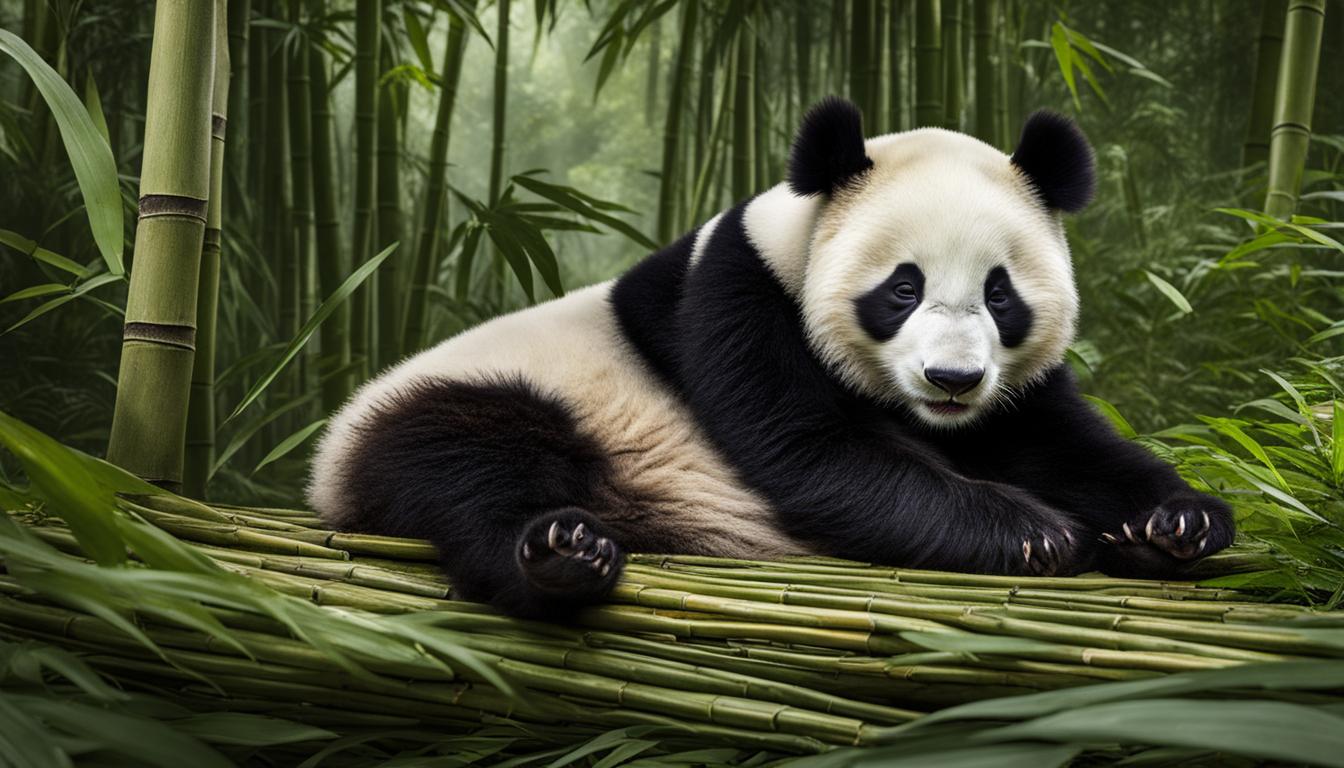Giant pandas are known for their unique reproductive process and the challenges they face in breeding, especially in captivity. However, recent studies have shown that wild panda populations can have reproductive rates comparable to thriving bear populations. In this article, we will explore the fascinating journey of panda reproduction, from their mating habits to the development of their adorable cubs.
When it comes to panda mating habits, these gentle giants reach sexual maturity between 5.5 to 6.5 years old. The breeding season usually occurs in the spring, between March and May. During this time, male pandas compete for the attention of females, and a female panda can mate with multiple males. The gestation period for pandas can range from 95 to 160 days, with an average of around 135 days.
When a panda gives birth, it is typically to a single cub, although twins are more common in captivity. The newborn panda cub is incredibly small, weighing only 90-130 grams and about 1/900th the size of its mother. They are born pink, wrinkly, and blind, and it takes time for their characteristic black and white fur to develop.
Panda cubs are completely dependent on their mothers for the first few months of their lives. They rely on their mother for warmth, milk, and protection. It is a remarkable journey to watch these tiny cubs grow and develop, gaining weight rapidly and becoming more independent as they learn to walk, climb, and eat solid foods.
In captivity, pandas face additional challenges in their reproductive journey. The unfamiliar environment and limited space can disrupt their mating and breeding behaviors. However, advancements in assisted reproductive technologies, such as artificial insemination, have improved breeding success in captivity.
Understanding the process of giant panda birth and raising cubs helps us appreciate these amazing creatures even more. Stay tuned as we delve deeper into their unique reproductive journey and discover the remarkable world of panda cub development.
Panda Mating Habits and Breeding Behavior
Giant pandas have unique mating habits and behaviors that contribute to their reproductive success. Understanding these behaviors is crucial for the conservation and breeding efforts in captivity. During the breeding season, which typically occurs in the spring between March and May, male pandas compete for the attention of females. This competition involves vocalizations, scent marking, and physical displays to assert dominance and attract mates.
Female pandas have a short window of fertility during this time, lasting only 2-4 days. They have the ability to mate with multiple males, increasing their chances of successful reproduction. This behavior is known as polyandry and is rare among mammals. Although pandas are solitary animals for most of the year, they come together during this brief period to mate.
While wild pandas engage in natural mating behaviors, captive pandas often require assistance in reproduction. Due to the unfamiliar environment and limited space, breeding behaviors may be disrupted. Artificial insemination is commonly used to enhance the reproductive success of pandas in captivity. This technique involves collecting semen from a male panda and inserting it into the female’s reproductive tract. Through advancements in assisted reproductive technologies, scientists and conservationists have made significant progress in improving the breeding success of pandas in captivity.
“By understanding panda mating habits and breeding behavior, researchers can create effective strategies to promote successful reproduction and ensure the long-term survival of this iconic species.”
| Mating Habits and Behavior | Key Points |
|---|---|
| Panda Breeding Season | The breeding season for pandas typically occurs in the spring between March and May. |
| Panda Mating | Pandas engage in polyandrous mating, where females can mate with multiple males during their short fertility window. |
| Pandas in Captivity | Artificial insemination is commonly used to enhance breeding success in captive pandas due to the challenges faced in captivity. |
| Conservation Importance | Understanding panda mating habits and breeding behavior is crucial for promoting successful reproduction and the conservation of the species. |
Panda Cub Development
Giant panda cubs go through a remarkable journey of growth and development. When they are born, they weigh only 90-130 grams and are about 1/900th the size of their mother. At this stage, they are pink, wrinkly, and blind. Over time, their characteristic black and white fur starts to develop, and they become more recognizable as pandas.
During the first few months of their lives, panda cubs are completely dependent on their mothers. They rely on their mothers for warmth, milk, and protection. It is an adorable sight to see the tiny cubs cuddled up next to their mother.
As the cubs grow, they gain weight rapidly and start to exhibit more independence. They learn to walk, climb, and explore their surroundings. By the time they are 8 to 9 months old, they are fully weaned and can eat solid foods. Most panda cubs leave their mothers when she becomes pregnant again, usually around 18 months.
| Development Milestones | Age |
|---|---|
| Birth | Newborn |
| Characteristics | Pink, wrinkly, blind, no fur |
| Dependency on Mother | Complete dependency |
| Weaning | 8 to 9 months old |
| Mother Separation | Around 18 months old |
Panda cubs continue to grow and develop as they approach adulthood. They gradually become more independent, learning essential skills such as climbing trees and foraging for food. By the time they reach sexual maturity, which occurs at around 4 years for females and 6 years for males, they are ready to reproduce and continue the cycle of birth and raising cubs.
Panda Reproduction in Captivity
Giant pandas are known for their difficulties in reproducing, especially in captivity. The unfamiliar environment and limited space can disrupt their mating and breeding behaviors. However, with advancements in assisted reproductive technologies such as artificial insemination, there have been significant improvements in breeding success for pandas in captivity.
In captivity, pandas are carefully monitored to optimize their reproductive success. Mating is often facilitated through artificial insemination, where sperm from a selected male panda is manually introduced into the female panda’s reproductive tract. This method allows for controlled breeding and increases the chances of a successful pregnancy.
Moreover, zoos and conservation centers have created conducive environments for pandas to stimulate natural breeding behaviors. These efforts include providing spacious enclosures, creating a suitable ambiance, and ensuring the pandas’ physical and mental well-being. By closely mimicking the conditions found in the wild, it helps pandas feel comfortable and more likely to engage in natural mating behaviors.
| Advantages of Captive Breeding for Pandas | Challenges of Captive Breeding for Pandas |
|---|---|
|
|
Despite the challenges, captive breeding programs have been successful in increasing the population of giant pandas and helping to preserve the species. These efforts play a crucial role in maintaining a genetically diverse and sustainable panda population, both in captivity and in the wild.
The Amazing Journey of Panda Birth
Witnessing the birth of a giant panda cub is an extraordinary experience. These tiny, fragile creatures enter the world weighing just a few ounces, completely dependent on their mothers for warmth, milk, and protection. The journey of panda birth is a remarkable process that showcases the resilience and adaptability of these gentle giants.
As the newborn cub grows, its black and white fur begins to develop, and it gains weight at a rapid pace. By the age of 5 months, the cub starts to gain independence, learning to walk, climb, and eat solid foods. It is truly awe-inspiring to witness their transformation from helpless newborns to playful and curious individuals.
“The birth of a panda cub is a symbol of hope for the conservation of this endangered species. It reminds us of the importance of protecting their natural habitats and ensuring their survival for future generations.” – Conservationist
Panda birth rates may be low, but each new addition to the population is a cause for celebration. These adorable cubs represent the future of the species, and their development is a testament to the efforts made in conservation and breeding programs. By understanding the process of panda birth, we can better appreciate the beauty and significance of these incredible creatures.
Panda Cub Development
A newborn panda cub weighs only 90-130 grams, about 1/900th the size of its mother. They are born pink, wrinkly, and blind, relying entirely on their mothers for care and nourishment. Panda cubs are completely dependent on their mothers for the first few months of their lives, and it’s a joy to see them grow and thrive under her watchful eye.
| Age | Development |
|---|---|
| 1 month | Fur begins to grow, cub starts to crawl |
| 3 months | Cub’s eyes start to open, begins teething |
| 5 months | Starts gaining independence, learns to walk and climb |
| 8 months | Mostly weaned, eats solid bamboo |
By the age of 18 months, most pandas leave their mothers when she becomes pregnant again. They continue to grow and develop on their own, gradually becoming more independent and acquiring the necessary skills to survive in the wild. It is a bittersweet moment as they embark on their own journey, ensuring the continuation of the panda population for generations to come.

A newborn panda cub is a testament to the wonders of nature and the resilience of these magnificent creatures. Their journey from birth to adulthood is an incredible story of growth, survival, and conservation. By understanding the intricacies of panda birth and cub development, we can truly appreciate the remarkable journey of these beloved animals.
Maturing into Adulthood
As panda cubs grow, they undergo a remarkable transformation, gradually gaining independence from their mothers and developing essential skills for survival. They learn to climb trees, an important ability for navigating their forest habitat and accessing food sources.
By the age of one, panda cubs are mostly weaned and weigh around 50-60 pounds. They continue to grow until they reach sexual maturity, which typically occurs at around 4 years for females and 6 years for males. Once sexually mature, pandas are ready to reproduce and continue the cycle of birth and raising cubs.
Maturing into adulthood is a critical phase for giant pandas, as their reproductive success is crucial for the survival of the species. Efforts to improve breeding success in captivity, such as artificial insemination, have shown promising results. These advancements in assisted reproductive technologies contribute to the preservation of the pandas and ensure their long-term survival.
Development Milestones
Here are some key milestones in the development of panda cubs:
- Birth: Panda cubs are born pink, wrinkly, and blind, weighing only 90-130 grams. They are completely dependent on their mothers for warmth, milk, and protection.
- Growth: Over time, the cubs’ characteristic black and white fur develops, and they gain weight rapidly. By the age of 5 months, they start gaining independence, learning to walk, climb, and eat solid foods.
- Weaning: Panda cubs are fully weaned at 8 to 9 months old, transitioning from their mother’s milk to a diet of bamboo and other vegetation.
- Separation: Most pandas leave their mothers when she becomes pregnant again, usually around 18 months. This separation marks the beginning of their individual lives as they venture out on their own.
As pandas mature, they play a vital role in maintaining the delicate balance of their ecosystem. By conserving their natural habitat and supporting breeding efforts, we can ensure the continued existence of these iconic creatures.
Conclusion
The reproduction and birth process of giant pandas is truly remarkable. Despite their reputation as poor breeders, studies have shown that wild panda populations can have reproductive rates comparable to thriving American black bear populations. This is a testament to their resilience and adaptability in their natural habitats.
While pandas face challenges in captivity, advancements in assisted reproductive technologies, such as artificial insemination, have improved breeding success. Twins are more commonly born in captivity, and close monitoring ensures the preservation of the species. These efforts are crucial for the conservation of these beloved creatures.
From the tiny, helpless newborn cubs, weighing only a few ounces, to the maturing adults, pandas go through a remarkable transformation. They rely entirely on their mothers for warmth, milk, and protection in the early stages of their lives. As they grow, their fur develops, and they gain independence, learning essential skills like walking, climbing, and foraging for food. In just a few short years, they reach sexual maturity and continue the cycle of birth and raising cubs.
Understanding the reproductive process and cub development of giant pandas allows us to appreciate these gentle giants even more. The journey from birth to adulthood is a testament to their resilience and the importance of conservation efforts to ensure their survival in the wild.
What is the process of raising giant panda cubs after they are born?
After the completion of the giant pandas reproduction cycle, the process of raising giant panda cubs is carefully managed. Mother pandas care for their cubs for about 18 months, teaching them how to climb, forage, and survive in the wild. Giant panda cubs require a lot of attention and nurturing during their early stages of life.
FAQ
What is the mating season for giant pandas?
The mating season for giant pandas occurs in the spring, usually between March and May.
How long is the gestation period for pandas?
The gestation period for pandas can range anywhere from 95 to 160 days.
How many cubs do pandas typically have?
Pandas typically give birth to a single cub, although twins are more common in captivity.
How long do panda cubs stay with their mothers?
Panda cubs are completely dependent on their mothers for the first few months of their lives and are fully weaned at 8 to 9 months old. Most pandas leave their mothers when she becomes pregnant again, usually around 18 months.
What is the average lifespan of a panda?
The average lifespan of a wild panda is 14 to 20 years, while pandas in captivity can live up to 30 years.
Do pandas have difficulties reproducing in captivity?
Yes, pandas face additional challenges to reproduction in captivity due to the unfamiliar environment and limited space. However, with advancements in assisted reproductive technologies such as artificial insemination, breeding success in captivity has improved.
What is the size and weight of a newborn panda cub?
A newborn panda cub weighs only 90-130 grams and is about 1/900th the size of its mother.
When do panda cubs start gaining independence?
Panda cubs start gaining independence at around 5 months old when they begin to learn how to walk, climb, and eat solid foods.
When do pandas reach sexual maturity?
Pandas reach sexual maturity between 5.5 to 6.5 years old.
How often do pandas reproduce?
The reproductive rate of pandas is about 1 cub every 2 years.











